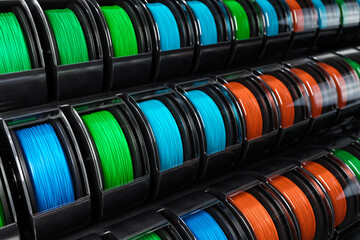3D printing has revolutionized the manufacturing industry, allowing for the creation of intricate designs and prototypes with ease. One of the key components of 3D printing is filament, the material used to build the printed objects layer by layer. While standard filaments come in a range of colors, the option to use color filaments adds an extra dimension to the creative possibilities. In this discussion, we will explore the pros and cons of using color filament in Color 3D printing. Keep reading:
Pros of Using Color Filament in 3D Printing
Enhanced aesthetics
One of the main advantages of using color filament is the ability to create prints that are visually appealing and vibrant. Colorful objects can be more eye-catching and engaging, making them ideal for showcasing products or prototypes. Additionally, the option to mix and blend colors gives designers the freedom to experiment and create unique designs that stand out.
Improved visual communication
Color filament allows for easy differentiation of different parts or components in a print. This can be particularly useful in engineering or architectural projects, where specific features or functionalities need to be clearly indicated. By using different colors, designers can enhance the clarity and effectiveness of their communication.
Easy identification of parts
Using different colors for various components or sections of a colour 3D print makes it easier to identify and assemble them correctly. This can be particularly beneficial in complex projects or when working with intricate designs that have multiple interconnected parts.
Educational purposes
Colorful 3D prints can be extremely useful in educational settings, such as schools or universities. By using color filament, educators can create visually engaging models and prototypes that aid in explaining complex concepts or demonstrating scientific principles. This enhances the learning experience and makes it more interactive for students.
Artistic expression
Color filament provides artists and designers with a new medium for expressing their creativity. By incorporating different colors and textures into their 3D prints, artists can bring their visions to life with stunning visual effects. Colorful prints can also be used to create unique sculptures or decorative objects that serve as works of art.
Fun and personal projects
Using color filament adds an element of fun to full-color 3d printing projects. Whether you’re creating toys, accessories, or home decor items, the ability to use vibrant colors can make the process more enjoyable. It’s also an opportunity to personalize objects by matching them to specific themes, preferences, or individual tastes.
Facilitates creativity and customization
In full-color 3d printer filament provides designers with the opportunity to unleash their creativity and produce intricate and detailed designs. The ability to incorporate different colors into 3D prints opens up new possibilities for customization and personalization. It also enables businesses to brand their products with specific colors, enhancing recognition and customer appeal.
Cons of Using Color Filament in 3D Printing
Higher cost
Color filaments generally come at a higher price compared to standard filaments. The additional pigments and dyes used to create a wide range of colors contribute to the increased cost. Moreover, complex or multi-color prints require more material, further adding to the overall expense. This can be a limiting factor for those on a tight budget or for larger-scale production.
Limited material options
While standard filaments have a wide range of material options such as PLA, ABS, or PETG, the availability of color filaments may be more limited. Some specialized materials used in specific industries may not be available in color options, limiting the choices for certain applications. It’s important to consider the material requirements when opting for color filament.
Potential for color inconsistencies
Achieving consistent and accurate colors can be challenging with color filament. Variations in print quality, temperature settings, and calibration can result in color inconsistencies between prints. This can be frustrating for designers or businesses seeking precise color representation in their products.
When using your color 3D printer, the filament offers numerous advantages, including enhanced aesthetics, improved visual communication, and increased creativity and customization. However, it’s essential to consider the potential drawbacks, such as higher costs, limited material options, and the possibility of color inconsistencies. Ultimately, the decision to use color filament will depend on individual preferences, project requirements, and budget constraints. With careful consideration, color filament can undoubtedly add a vibrant touch to your 3D printed creations.



